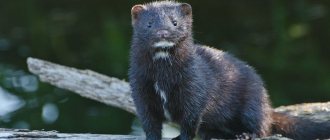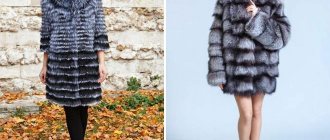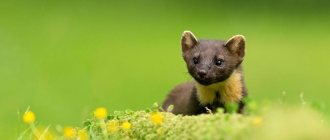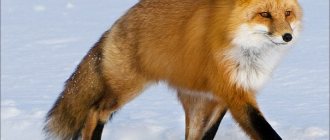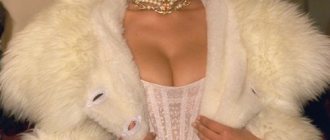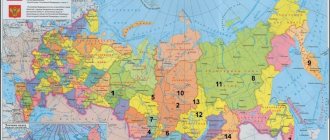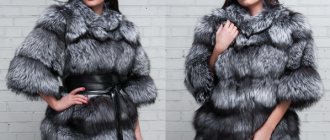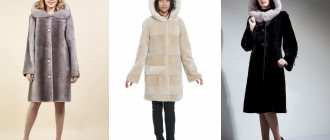- Wild animals
- >>
- Mammals
Honoriki are small fluffy animals belonging to the mustelidae family. These animals are often kept as pets. The species was obtained as a result of a hybrid of the steppe and forest ferret with the European mink. The name honorik , formed from the merger of the names of the parents, is used only in Russia; all over the world these animals are called, like ordinary domestic ferrets, fretka (fretka, or fredka).
Origin of the species and description
Photo: Honorik
Honorik is a hybrid species resulting from crossing Mustela eversmanni (forest ferret), Mustela eversmanni (steppe ferret) and Mustela lutreola (European mink). This species was bred by the famous Soviet zoologist Dmitry Ternovsky in 1978. Since this species is artificially bred, these animals can be found mainly in captivity, although honoriki are also found in the wild.
Externally, Honoriki differ little from ordinary ferrets. The body of animals is thin and flexible. These animals have a thin and rather long neck, a small rounded head, and a long, fluffy tail, which Honorik inherited from the European mink. Honorik is slightly larger than normal ferrets. An adult weighs from 400 grams to 2.6 kg. The height of the animal is about 50 cm, the length of the tail is about 15-18 cm.
Video: Honorik
Honoriki differ from ferrets in their thick and fluffy fur and specific coloring. These animals received black hair from minks; it is equally evenly distributed throughout the brownish underfur. From ferrets, animals inherited a flexible body shape and large ears bordered by a white stripe.
In recent years, these animals are practically not raised in animal farms due to the rarity of minks and the difficulty of breeding animals, and increasingly, traders under the guise of honors are selling ordinary ferrets. But real honoriki are still the result of crossing three species; you can distinguish an honoriki from an ordinary ferret by the structure of their fur, the presence of a black spine and a fluffy long tail.
Women's fur coat models
Honorik fur coats in the catalog are presented in a wide variety of model variations. The sizes and shades of the skins of this animal allow you to sew fur coats of a wide variety of styles. The catalogs present the most popular models.
The trend is classic silhouettes, complemented by some modern elements. Light flares highlight many fur coat models. Large, voluminous hoods have become an adornment of many women's styles.
The main fashion trends of recent years can be identified:
- simplicity of styles,
- classic elements,
- presence of a hood,
- no collar,
- combined models,
- color contrast,
- original accents.
Appearance and features
Photo: What honorik looks like
Honoriki are small animals with a long and thin body. Very nimble and fast. The animal's head is small. The eyes are small, the iris is brown. The chin and upper lip are white; most honors have light stripes behind the eyes and on the ears of the animal. There are long mustaches near the nose. The wool is thick, better than that of mink, its structure is more similar to sable, the length of the spine is about 4 cm, the underfur is 2-2.5 cm.
The underfur is usually brown or brown in color. The limbs are small, however, this does not prevent honoriki from moving quickly enough. The tail is quite long, about 15-20 cm; the hair on the tail is especially long and fluffy. Since Honoriki are a species, artificially bred male Khanoriki are sterile and cannot bear offspring. But females are capable of producing healthy offspring when crossed with ferrets.
Interesting fact: Honorites have well-developed anal glands, which secrete an unpleasant-smelling liquid; males use it to mark their territory and repel the enemy when in danger.
Honoriki adapt well to environmental conditions. In winter, the animals are protected from the cold by their thick fur; closer to summer, the animals begin a period of active molting, during which the animal’s fur is renewed. In addition, the frequency of metabolism and the amount of gas exchange change at different times of the year.
In the summer, animals weigh less, the fat layer is practically absent, by winter the animals gain up to 30% of their own weight, an impressive fat layer appears, and the hair grows back. The lifespan of these animals in the wild is about 5 years; in captivity, these animals can live up to 12 years.
What kind of fur coats are made from honorik?
Fur coats of a wide variety of models and styles are sewn from honorik - classic fur coats, short fur coats with a horizontal cut, straight and fitted models, with hoods and stand-up collars, fashionable wrap-around fur coats, cardigans, ponchos, coats, vests, tulips and balloons , with narrow or voluminous sleeves, with or without a belt. Thanks to the versatility and high quality of the fur, it is perfect for sewing fur coats for every taste. Honorik lends itself well to dyeing, so a fur coat made from it can be light, dark, bright - anything.
Where do honoriki live?
Photo: Home honor
Since honoriki are artificially bred animals, it is quite difficult to find them in the wild. In the natural environment, honoriki are found in the habitats of their ancestors. Honoriki can live in central and southern Russia, western Europe, Eurasia and central Asia.
Honoriki are found in the Czech Republic, Romania, Moldova, Hungary, Poland, Bulgaria and in Ukraine. In the wild, animals live mainly in forests and forest-steppe. Animals make holes for themselves where they live. They like to settle near bodies of water, honoriki have inherited the ability to swim well, and in the summer heat they can spend a lot of time in the water.
Honoriki are often kept as pets. In captivity, it is better to keep these animals in separate cages, in which a hammock or soft blanket is placed. It is better to place the cage with the animal in a quiet, warm place, protected from drafts. Honoriki are quite smart animals, they quickly get used to the tray and know a place to eat. The animal's cage should be spacious and always clean.
An animal cannot sit in a cage all day, because it needs to move, so honorees are often allowed to walk freely around the apartment. It’s true that it’s better not to leave animals unattended. Honor animals can hide in the most secluded places, climb into the washing machine and trash can, so when leaving home it is better to lock the animal in a cage.
Slang meaning
The word “hanurik” appeared in everyday life thanks to former prisoners. When released, they used specific expressions out of old habit, and they settled in the speech of ordinary people.
Hanurik is a degraded, insignificant and cowardly person. It parasitizes soft-bodied people; the hanurik has no desire to work. A parasite respects alcohol, gatherings of his own kind, and discussions about his difficult lot. He knows how to elicit pity, which he uses successfully.
In addition to a degenerate parasite, this is what they call an ordinary alcoholic, regardless of his type and financial situation.
What do Honoriki eat?
Photo: Honorik in nature
Honoriki are omnivores and they eat basically the same things as ferrets.
The diet of honors includes:
- mice of all kinds;
- toads;
- frogs;
- fish;
- water rats;
- wild birds and their eggs;
- large insects: locusts, grasshoppers, dragonflies and others.
Sometimes ferrets enter the burrows of hares and strangle the hares. In captivity, Honoriki are usually fed boiled poultry meat, eggs, porridge, boiled fish, vegetables and fruits. Under no circumstances should these animals be given smoked or salted foods, as the animals may die from such food. Honoriki are active animals and they constantly need a lot of food and water.
Water should be in the cage at all times; it is better to pour it into a sippy cup so that the animal does not spill the water. In order for an animal to feel good, it is necessary to feed it with high-quality food; uneaten leftover food must be removed from the cage, as uneaten food quickly spoils, and the animal can become poisoned by eating spoiled food. If you don’t want to develop your pet’s diet, you can buy ready-made dry balanced food at a pet store.
When letting the animal out for a walk around the house, it is necessary to keep an eye on it, since ferrets love to chew wires, climb into trash cans and closets, where the animal can also become poisoned by eating something inedible or spoiled. In the summer, honors can be fed less; it is also necessary to dilute the diet with vegetables and fruits. In winter, animals require more meat. In order for your pet to feel good, it is good to add vitamin complexes for ferrets, sold in pet stores, to the diet.
How to care for the product?
A fur coat made from honorik does not require complex care; general rules apply to it - between winter seasons it is better to store the product in a case, in a dry and ventilated place. You cannot dry such a fur coat near a radiator or air conditioner, so as not to spoil the fur. The fur itself must be combed periodically. You should not carry a bag on your shoulder, so as not to rub off bald spots, and you should not spray your fur coat with perfume.
Features of character and lifestyle
Photo: Honoriki
Honoriki are very active animals. They swim very well, run fast and easily climb even into the most inaccessible places. In the wild, animals quickly dig holes and are good at hunting mice, birds, amphibians and snakes. Very agile and nimble. They hide in holes from enemies and are able to dig deep passages, both in the ground and in the snow.
Honors have an aggressive character; we must not forget that these are, after all, predatory animals. Honoriki can live next to a person and even recognize him as the owner, but they can behave aggressively. Therefore, these animals should not be kept in families with small children; you should also not have hanoriks if you have hamsters, rats, or birds, because they can become the prey of this small predator. But these animals get along well with cats and dogs.
They are especially active at night. When animals are not sleeping, they are restless, honors are constantly moving, running and jumping. They love to play with each other and with their owner, and do not like loneliness. Domestic honoriki practically do not smell; even in danger, animals can smell slightly musk, but wild honoriki, when in danger, secrete a sharp-smelling liquid from the anus.
Honoriki are very smart animals, they are easy to train. When animals feel comfortable, they let the owner know about it by pleasantly cooing. When experiencing dissatisfaction and rage, the honorik may snort and hiss with displeasure. If an animal is in serious danger, it may even scream. Little Honoriki squeak, letting others know that they are hungry.
Interesting fact: The character of an honor child is formed by 4 months; it is at this age that you can start working with animals - accustoming them to the tray and other commands.
Females are better trainable, males are more devoted to their owner, but are lazy. The bad character traits of these animals include their persistence. If an animal wants something, it will demand and get its way. It is almost impossible to wean an animal from bad habits of chewing wires or digging up soil in flower pots, so it is better to immediately prohibit the animal from negative actions, and when releasing it from the cage, monitor every step of the animal.
LiveInternetLiveInternet
Column and Honor
Ferrets
We used to think that ferrets steal chickens and smell bad. But it's not that simple. These guys already walk on leashes and sleep on soft mattresses. It’s true that the owners who gave them such freedom, before putting on a coat, had better check the sleeves and pockets so that when they go out into the street they don’t scare the neighbors with the speedy living creatures that suddenly jump out of their clothes.
The behavior of ferrets is very special, sometimes they say that it resembles a cross between the behavior of a cat and a dog. Like dogs, they get used to their owner and can be taught to respond to a name, while ferrets have a more independent character. They, like cats, love affection and become very accustomed to the house.
The domestic ferret is a black (forest) ferret that is widespread in the forests of Europe. This is a predator from the mustelid family, its relatives are weasel, ermine, sable, marten, badger, etc.
Domesticated ferrets are mentioned in the works of Aristotle and Aristophanes. In those days, people used these animals to hunt rabbits and kill rodents.
Leonardo da Vinci's legendary 1489 painting "Lady with an Ermine" depicts an albino ferret, not an ermine.
Prejudices Ferrets are rodents
The most common misconception. Ferrets are not rodents like rats or hamsters, but are predators that rely on small rodents as food. Ferrets have much more in common with dogs and cats than they do with rodents.
Ferrets are very smelly
The ferret is popularly considered the most smelly animal after the skunk; To this day, in villages, fables are told about how a ferret gets into a chicken coop and releases a “stinker”, the smell of which causes the chickens to fall from their roost, and the animal can only pick them up. In reality, ferrets secrete secretions in rare cases - when they are very frightened or excited. A specific musky smell emanates from the skin of ferrets, but not at all strong.
Ferrets are vicious, aggressive and biting animals.
Some people are sure that ferrets, even those born at home, grow up wild, very vicious and bite at the first opportunity. This is very far from the truth. Statistics show that much more people suffer from the aggression of such truly domestic animals as dogs than from the aggressive behavior of ferrets.
X honoriki
Honoriki are hybrids between ferrets and mink. Honorik (“ho” - ferret, “nor” - mink) was bred in 1978 by D. Ternovsky. About 20 years ago they were bred in fur farms.
Occasionally, honors are also found in nature at the intersection of the ranges of the ferret and the European mink. Honoriki look like mink, and in color and fur they resemble dark sable. They inherit the ability to swim from minks, and from ferrets they inherit the ability to intensively dig holes. By nature, Honoriki are very aggressive and do not get used to people well.
In terms of quality and beauty of fur, Honorik was significantly superior to his parents. The skins of the animals and their offspring caused sensations at many international exhibitions, were repeatedly awarded medals at the Exhibition of Economic Achievements in Moscow and were widely promoted by the media.
Columns
Speakers are recognized as especially attractive representatives of the mustelidae family.
.
Genetically, these animals are closest to the European mink. Some scientists distinguish the Sakhalin weasel as an independent species, calling it itatsi - Mustela
itatsi
. The animals live in floodplains and there are very few left, 200-300 of them.
Itatsi
From the story about the columns of Elena Lukina (Komsomolsk-on-Amur)
You can keep the column at home. The animals are clean, the toilet is always in one place. They constantly like to wipe their skin; to do this, you need to put hay, napkins, and rags in the cage, and throw them away periodically. Animal excretions, especially during the rutting season, cause the litter to become damp. I pour ash into the pan, which absorbs odors.
When they were young, my speakers once tried to swim in an aquarium, but later they began to treat the water with caution. It is better not to let the animals out of the cage; their dexterity and ability to penetrate everywhere and everything will not lead to good. Like dogs, they are endowed with a hunting instinct; like cats, they climb well, jump, and play cat and mouse with their prey. They can get into pockets, sleeves, etc. run over your head or climb you like a tree, clinging with sharp claws. The speakers respond well to nicknames and understand individual keywords, especially voice intonation. They recognize the owner and are wary of strangers. When communicating with them, it seems that they are studying you, they feel your mood and know what you want or what they can get from you.
In the morning they patiently wait for me to wake up, and then wild joy begins, expressed in jumping around the cage and crawling on their belly. Having jumped up, they fall apart on the shelves, sticking out their pink dog tongues. In the evening, speaker activity stops when the lights are turned off. Sleep sleep! The former nocturnal activity of the speakers was replaced by adaptation to the rhythm of family life by the age of one year.
full text https://www.horekdony.ru/page-id-135.html
And these guys eat fresh chicken meat, fish, quail eggs, rats and mice.
photo from sites: student.vetdoctor.ru/ru/index.php?showtopic=3844,
www.xorek.ucoz.ru/forum/21-137-1
https://www.kolonok-animal.ru/care.html
www.inferret.ru/forums-m-posts-q-2459.html
www.teensclub.ru/index.php?act=Print&client=p…
ljtop.blogspot.com/2008/05/blog-post_7586.html
https://www.liveinternet.ru/community/803453/blog
Social structure and reproduction
Photo: Little Honorik
Since honoriki are a hybrid species, males of these animals cannot have offspring. Females are fertile and are able to bear offspring several times a year when mated with regular ferrets. The mating season for Honorites begins in the spring and lasts until late autumn. Closer to spring, the gonads of animals become significantly enlarged.
In females, a loop—the edge of the urethra—becomes noticeable; in males, the testes enlarge at this time. Mating in animals occurs quite rapidly. The male can pursue the female, or grab her by the neck and drag her to a secluded place. When mating, the female squeaks and tries to break free and run away. After mating, females usually have their withers stripped, you can see teeth marks on the withers, this is normal and the female’s wounds will heal quickly.
The offspring are born 1.5 months after conception. Before giving birth, a pregnant female is usually placed in a separate cage so that the male does not harm the offspring. One litter contains from 2-3 to 8 cubs. The cubs are born with completely white fur and are completely blind. Small ferrets grow very quickly feeding on their mother's milk. At about a month old, ferrets begin to eat meat.
Fun Fact: Ferret puppies have an innate instinct to follow a moving body. As soon as the cubs begin to confidently stand on their paws, they begin to follow their mother. Juveniles are ready for mating at the age of 6-7 months.
Natural enemies of honorists
Photo: What honorik looks like
Natural enemies of honorists include:
- wolves;
- jackals;
- foxes;
- lynx;
- dogs;
- wild cats;
- large snakes;
- eagles, hawks, falcons and other large birds of prey.
Honoriki are very careful and nimble animals, and they rarely fall into the clutches of predators. Typically, young ferrets and old, weak animals become prey for predators. These enemies are not scary for domestic honor animals, however, domestic honor animals are often susceptible to various diseases.
Such as:
- carnivore plague;
- parvovirus enteritis;
- rabies;
Most diseases can be prevented by giving the animal the necessary vaccinations and feeding the animal a balanced diet. If the animal becomes ill, it is necessary to contact a veterinarian, who will prescribe the correct treatment. It is not advisable to treat the animal yourself, as this can lead to unpredictable results.
To prevent diseases, try to monitor your pet, avoid contact with sick animals, clean the cage more often and ventilate the room where the animal is located. Ferrets often get fleas; these parasites can be gotten rid of with drops and shampoos that are used for cats. Minor scratches and abrasions are not scary for animals; they heal quickly; you just need to make sure that the wound does not fester.
Price and reviews about Honorica
The price for an honor dog can vary, depending on where you purchase the animal. From a breeder without a license, an honorik can cost from 3,000 - 4,000 rubles, while from professional breeders with a guarantee of health and pedigree, the cub can cost tens of times more.
Before getting such an animal, you need to read reviews about the honors of their owners. Perhaps the complexity of keeping and the problems faced by the owners of these animals will force them to reconsider their decision.
